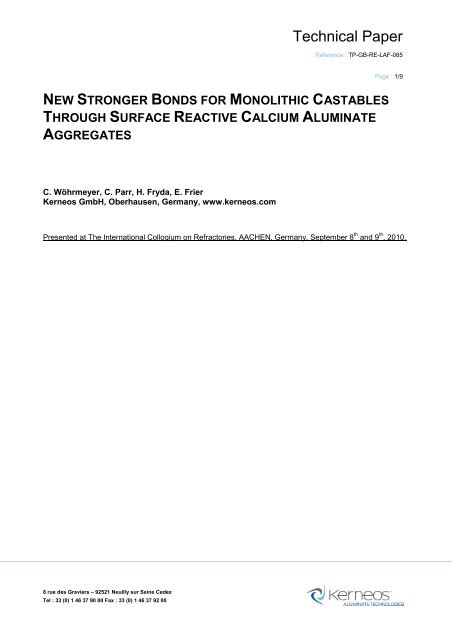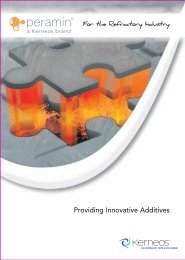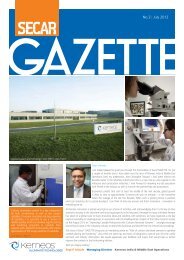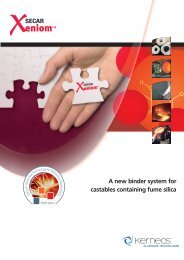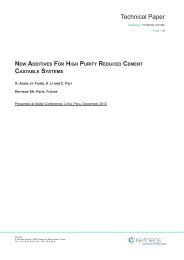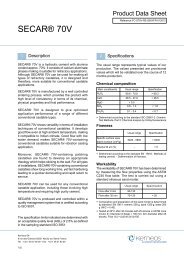Download the document - SECAR®, solutions for refractories
Download the document - SECAR®, solutions for refractories
Download the document - SECAR®, solutions for refractories
You also want an ePaper? Increase the reach of your titles
YUMPU automatically turns print PDFs into web optimized ePapers that Google loves.
Technical Paper<br />
Reference : TP-GB-RE-LAF-085<br />
Page : 1/9<br />
NEW STRONGER BONDS FOR MONOLITHIC CASTABLES<br />
THROUGH SURFACE REACTIVE CALCIUM ALUMINATE<br />
AGGREGATES<br />
C. Wöhrmeyer, C. Parr, H. Fryda, E. Frier<br />
Kerneos GmbH, Oberhausen, Germany, www.kerneos.com<br />
Presented at The International Colloqium on Refractories, AACHEN, Germany, September 8 th and 9 th , 2010.<br />
8 rue des Graviers – 92521 Neuilly sur Seine Cedex<br />
Tel : 33 (0) 1 46 37 90 00 Fax : 33 (0) 1 46 37 92 00
Technical Paper<br />
Reference : TP-GB-RE-LAF-085<br />
Page : 2/9<br />
ABSTRACT<br />
This investigation studies <strong>the</strong> influence of calcium aluminate aggregates on refractory castable<br />
properties in comparison to bauxite and fireclay aggregates. Calcium aluminate aggregates with a<br />
mineralogical composition similar to CAC are able to develop stronger bonding <strong>for</strong>ces with <strong>the</strong><br />
cement than aggregates from <strong>the</strong> alumina-silica system. The chemical affinity between <strong>the</strong> calcium<br />
aluminate aggregates and <strong>the</strong> matrix enables direct chemical linkages via calcium aluminate<br />
hydrate bridges. During <strong>the</strong> de-hydration period and <strong>the</strong> re-crystallisation of anhydrous calcium<br />
aluminate phases, <strong>the</strong> linkages between <strong>the</strong> calcium aluminate matrix and <strong>the</strong> surface of <strong>the</strong><br />
calcium aluminate aggregates remain stronger since <strong>the</strong> aggregates are of a similar mineralogical<br />
nature as <strong>the</strong> anhydrous cement. This effect results in higher strength compared to bauxite even<br />
though <strong>the</strong> density is lower with <strong>the</strong> fused calcium aluminate aggregate R50. For a given furnace<br />
design, 10% less material is needed to fill <strong>the</strong> <strong>for</strong>ms, and better insulation properties and energy<br />
savings are expected. This makes R50 interesting <strong>for</strong> many applications where good heat<br />
containment, abrasion resistance and low liquid penetration in combination with low accretion<br />
build-up are required. In aluminium contact areas, it can even be used with less or without antiwetting<br />
additives which makes it more temperature resistant.<br />
The sintered calcium aluminate aggregate R60 has a higher intrinsic open porosity than R50. It<br />
makes castables even lighter than with fireclay but without negative effects with respect to bending<br />
strength.<br />
Both R50 and R60 are calcium aluminate aggregates which suit applications up to 1350°C-<br />
1400°C, <strong>for</strong> example, in secondary aluminium furnaces, back-up linings in many industrial<br />
furnaces, DRI-production, boilers and re-heating furnaces.<br />
8 rue des Graviers – 92521 Neuilly sur Seine Cedex<br />
Tel : 33 (0) 1 46 37 90 00 Fax : 33 (0) 1 46 37 92 00
Technical Paper<br />
Reference : TP-GB-RE-LAF-085<br />
Page : 3/9<br />
1 Introduction<br />
In recent years, <strong>the</strong> refractory raw material<br />
situation has become a critical and even political<br />
subject mainly driven by <strong>the</strong> high demand <strong>for</strong><br />
refractory aggregates as consequence of <strong>the</strong><br />
booming steel industry in China. In 2009, China<br />
counted <strong>for</strong> 47% of <strong>the</strong> global crude steel<br />
production (568 Mio t out of global steel output of<br />
1220 Mio t) vs. only 15% just 10 years back when<br />
China produced only 127 Mio t of <strong>the</strong> total of 848<br />
Mio t [1]. On <strong>the</strong> o<strong>the</strong>r hand, China is one of <strong>the</strong><br />
very few countries with very important geological<br />
reserves <strong>for</strong> refractory grade bauxite [2]. Only 10<br />
years ago, a large amount of this bauxite was<br />
available <strong>for</strong> <strong>the</strong> global refractory industry at low<br />
prices. But now, China needs a large portion of this<br />
bauxite <strong>for</strong> its own aluminium and steel production.<br />
China’s steel production has more than quadrupled<br />
during <strong>the</strong> last 10 years. This situation has even<br />
become a political issue. The Commission of <strong>the</strong><br />
European Communities launched a position paper<br />
in 2008 with <strong>the</strong> title “The raw materials initiative –<br />
Meeting our critical needs <strong>for</strong> growth and jobs in<br />
Europe” [3]. However, political processes need<br />
<strong>the</strong>ir time and can only try to improve <strong>the</strong> trade<br />
rules and stimulate research in new raw materials.<br />
The European refractory and raw materials<br />
industries need to develop strategies to adjust to<br />
<strong>the</strong> dramatically changed global situation and need<br />
to turn it into new opportunities. An example <strong>for</strong> <strong>the</strong><br />
use of new calcium aluminate aggregate based<br />
products was given by [4] which proposed calcium<br />
aluminate aggregates <strong>for</strong> tin bath bottom bricks to<br />
overcome problems with alkalis when aggregates<br />
from alumina-silica systems are used. O<strong>the</strong>r<br />
publications discussed <strong>the</strong> application of calcium<br />
aluminate aggregates in bricks [5] and castables<br />
[6, 7] <strong>for</strong> non-ferrous and o<strong>the</strong>r industries. This<br />
present paper will specifically study <strong>the</strong> calcium<br />
aluminate aggregates and <strong>the</strong>ir surface reaction<br />
with <strong>the</strong> binder phase. When calcium aluminate<br />
aggregates consist of hydraulic phases like CA<br />
and CA2, <strong>the</strong>y can interact chemically during<br />
hydration and de-hydration with <strong>the</strong> calcium<br />
aluminate binder, unlike those calcium aluminate<br />
aggregates which consist of CA6, corundum or<br />
mullite. Specifically, <strong>the</strong> effect of this stronger bond<br />
on <strong>the</strong> physical properties of castables will be<br />
investigated in this paper, in comparison to bauxite<br />
and fireclay in similar <strong>for</strong>mulations.<br />
Calcium Aluminate Aggregates<br />
Calcium aluminate cement is well-known <strong>for</strong> many<br />
years as <strong>the</strong> binder <strong>for</strong> refractory castables. Also,<br />
calcium aluminate aggregates are known from<br />
peri-refractory applications (ALAG ® ) and from<br />
fluxing applications <strong>for</strong> metallurgical slags (LDSF ® ).<br />
Both are fused materials and start to melt below<br />
1400°C, ALAG ® due to its relatively high iron oxide<br />
content combined in different aluminate phases<br />
and LDSF ® due to its high C12A7 mineral phase<br />
content (Tab. 1, 2). ALAG ® is, <strong>for</strong> example, used in<br />
<strong>the</strong> back-up zones of blast furnace cast houses<br />
and <strong>the</strong> blast furnace slag granulation station.<br />
O<strong>the</strong>r fields of application are <strong>the</strong> ramps in coke<br />
oven plants and industrial floors in <strong>the</strong> aluminium<br />
industry where high abrasion resistance is<br />
required. A low iron oxide, fused calcium aluminate<br />
aggregate (R50) <strong>for</strong> castables has been presented<br />
by [6]. Compared to ALAG® <strong>the</strong> R50 product<br />
contains more Al 2 O 3 . This results, unlike what is<br />
stated in [8], in a very low C12A7 phase content<br />
(
Technical Paper<br />
Reference : TP-GB-RE-LAF-085<br />
Page : 4/9<br />
Tab.1: Chemistry and mineralogy of aggregates<br />
Calcium aluminate Fireclay Bauxite<br />
R60 R50 ALAG ® LDSF ® FC B<br />
Sintered Fused Fused Fused Sintered Sintered<br />
Chemistry<br />
Al 2O 3 62 52,5 39,5 41 45,6 89,5<br />
SiO 2 6 5,5 4,5 3,5 51,5 4<br />
CaO 26 37 37,5 50,5 0 0,1<br />
Fe 2O 3 2,5 2 15,5 2 0,9 1,5<br />
TiO 2 2,5 2 2 2 1,7 3,7<br />
Mineralogy (A= Al 2O 3, S=SiO 2, C=CaO, F=Fe 2O 3)<br />
A - - - - - XXX<br />
A3S2<br />
S<br />
CA2<br />
CA<br />
C12A7<br />
C3A<br />
C2S<br />
C2AS<br />
C4AF<br />
- - - - XXX X<br />
- - - - XX X<br />
XXX - - - - -<br />
X XXX XXX - - -<br />
- - X XXX - -<br />
- - - X - -<br />
- - - X - -<br />
XX XX X - - -<br />
- - X - - -<br />
XXX= main phase, XX=secondary phase,<br />
X= minor phase, - = below 1%<br />
2 Test Methods<br />
Classical castable test methods such as vibration<br />
flow, porosity by water immersion and strength<br />
measurements have been used to study <strong>the</strong> basic<br />
castable properties. Quantitative chemical and<br />
mineralogical analyses have been conducted using<br />
XRF and XRD methods. Model regular castables<br />
(Tab. 2, 3) and deflocculated medium cement<br />
castables (MCC) have been investigated (Tab. 4).<br />
Tab. 2: Model regular castable recipes CC-FC and<br />
CC-R60<br />
mm CC-FC CC-R60<br />
R60 3-6 % - 28<br />
R60 1-3 % - 25<br />
R60 0-1 % - 22<br />
Fireclay 3-6 % 28 -<br />
Fireclay 1-3 % 25 -<br />
Fireclay 0-1 % 22 -<br />
Secar 51 % 25 25<br />
H 2O % 8,5 10,5<br />
Working time min 240 220<br />
3 Test Results<br />
Calcium aluminate aggregate (R60) in regular<br />
castable<br />
The R60 aggregate is a sintered calcium aluminate<br />
with about 30% open porosity, higher than <strong>for</strong><br />
bauxite or dense fireclay aggregates. Fig. 1<br />
compares <strong>the</strong> rheology of <strong>the</strong> fireclay-based<br />
castable CC-FC with <strong>the</strong> R60-based CC-R60. Both<br />
need <strong>the</strong> same amount of water to reach identical<br />
initial flow properties. While fluidity under vibration<br />
slightly increases during <strong>the</strong> first 30 minutes and<br />
<strong>the</strong>n stays almost stable when fireclay is used, <strong>the</strong><br />
flow decays in <strong>the</strong> case of CC-R60 due to <strong>the</strong><br />
higher pore volume into which <strong>the</strong> water can<br />
migrate over time. Then, less water is available to<br />
fluidise <strong>the</strong> cement matrix and <strong>the</strong> castable starts<br />
to stiffen. It is assumed that <strong>the</strong> drop in flow is not<br />
caused by <strong>the</strong> mineralogy of R60 since it contains<br />
mineral phases which have low hydraulic<br />
properties at 20°C (Tab. 1). The observed<br />
stiffening effect with R60 could be of interest <strong>for</strong><br />
gunning mixes but has not been fur<strong>the</strong>r studied<br />
here.<br />
After firing at 800, 1100 and 1350°C, <strong>the</strong> bulk<br />
density of CC-R60 is about 5% lower than CC-FC<br />
(Fig. 2) and <strong>the</strong> open porosity is almost 40% higher<br />
(Fig. 3). With classical aggregates from <strong>the</strong><br />
8 rue des Graviers – 92521 Neuilly sur Seine Cedex<br />
Tel : 33 (0) 1 46 37 90 00 Fax : 33 (0) 1 46 37 92 00
Technical Paper<br />
Reference : TP-GB-RE-LAF-085<br />
Page : 5/9<br />
alumina-silica system, one would expect a drop in<br />
strength [9]. But in this case, despite <strong>the</strong> lower bulk<br />
density and higher porosity, flexural strength is <strong>the</strong><br />
same as CC-FC (Fig. 4).<br />
Vibration flow (mm)<br />
240<br />
220<br />
200<br />
180<br />
160<br />
140<br />
120<br />
100<br />
CC-FC<br />
0 30 60 90<br />
Time (min)<br />
CC-R60<br />
Fig. 1: Vibration flow of regular castables CC-FC and<br />
CC-R60 at 20°C<br />
Bulk density (g/cm3)<br />
2,5<br />
2,3<br />
2,1<br />
1,9<br />
1,7<br />
1,5<br />
CC-FC<br />
CC-R60<br />
800 1100 1350<br />
Temperature (°C)<br />
Fig. 2: Bulk density of regular castables CC-FC and<br />
CC-R60<br />
Open porosity (Vol.%)<br />
30<br />
28<br />
26<br />
24<br />
22<br />
20<br />
18<br />
16<br />
14<br />
12<br />
10<br />
CC-FC<br />
CC-R60<br />
800 1100 1350<br />
Temperature (°C)<br />
Fig. 3: App. porosity of regular castables CC-FC and<br />
CC-R60<br />
CMOR (MPa)<br />
10<br />
9<br />
8<br />
7<br />
6<br />
5<br />
4<br />
3<br />
2<br />
1<br />
0<br />
CC-FC<br />
CC-R60<br />
800 1100 1350<br />
Temperature (°C)<br />
Fig. 4: CMOR of regular castables CC-FC and CC-<br />
R60<br />
R50 in regular castables<br />
The fused and dense R50-aggregate has been<br />
compared with Chinese bauxite aggregate in a<br />
model recipe as shown in Tab. 3. As can be seen<br />
in Fig. 5, both casables exhibit a very similar flow<br />
profile with <strong>the</strong> same amount of mixing water. Due<br />
to <strong>the</strong> dense R50-grains, no flow decay has been<br />
observed. The dense grains, toge<strong>the</strong>r with <strong>the</strong><br />
mineralogy of R50, with its high calcium<br />
monoaluminate and low C12A7-content (
Technical Paper<br />
Reference : TP-GB-RE-LAF-085<br />
Page : 6/9<br />
Tab. 3: Model regular castable recipes CC-R50 and<br />
CC-BX<br />
Vibration flow (mm)<br />
mm CC-R50 CC-BX<br />
R50 3-5 % 31 -<br />
R50 1-3 % 20 -<br />
R50 0-1 % 29 -<br />
Bauxite 3-6 % - 31<br />
Bauxite 1-3 % - 20<br />
Bauxite 0-1 % - 29<br />
Secar 51 % 20 20<br />
H 2O % 9.7 9.7<br />
Working time min 240 240<br />
230<br />
220<br />
210<br />
200<br />
190<br />
180<br />
170<br />
160<br />
CC-R50<br />
T0 T30 T60 T90 T120<br />
Time (min)<br />
CC-BX<br />
Fig. 5: Vibration flow of regular castables CC-R50<br />
and CC-BX at 20°C<br />
Bulk density (g/cm3)<br />
2,8<br />
2,7<br />
2,6<br />
2,5<br />
2,4<br />
2,3<br />
2,2<br />
CC-R50<br />
CC-BX<br />
CMOR (MPa)<br />
12<br />
10<br />
8<br />
6<br />
4<br />
2<br />
0<br />
CC-R50<br />
CC-BX<br />
20 (6 h) 20 (24h) 110 800 1200<br />
Temperature (°C)<br />
Fig. 7: CMOR of regular castables CC-R50 and CC-<br />
BX<br />
delta L (%)<br />
1<br />
-1<br />
-2<br />
-3<br />
-4<br />
-5<br />
CC-R50<br />
CC-BX<br />
0<br />
0 200 400 600 800 1000 1200 1400<br />
Temperature (°C)<br />
Fig. 8: Refractoriness under load (0.2 MPa) of regular<br />
castables CC-R50 and CC-BX<br />
R50 in deflocculated medium cement castables<br />
(MCC)<br />
The effect of R50 in a medium cement containing<br />
model recipe (MCC) with different amounts of<br />
barium sulphate (as an anti-wetting material <strong>for</strong><br />
aluminium contact areas) is shown in Tab. 4.<br />
Whilst <strong>the</strong> barium sulphate is absolutely necessary<br />
to get <strong>the</strong> required anti-wetting effect <strong>for</strong> <strong>the</strong><br />
bauxite mix, <strong>the</strong> amount can be reduced or even<br />
completely eliminated when R50 is used [6].<br />
2,1<br />
110 800 1200<br />
Temperature (°C)<br />
Fig. 6: Bulk density of regular castables CC-R50 and<br />
CC-BX<br />
8 rue des Graviers – 92521 Neuilly sur Seine Cedex<br />
Tel : 33 (0) 1 46 37 90 00 Fax : 33 (0) 1 46 37 92 00
Technical Paper<br />
Reference : TP-GB-RE-LAF-085<br />
Page : 7/9<br />
Tab. 4: Model MCC recipes with bauxite (B1-B3) and<br />
R50 (R1-R3) with different barium sulphate contents.<br />
Bauxite<br />
R50<br />
B1 B2 B3 R1 R2 R3<br />
R50 3-5 mm % - 33<br />
R50 1-3 mm % - 12<br />
R50 0-1 mm % - 20<br />
SECAR ® 51 % - - 5 5<br />
Bauxite 3-6 mm % 21 -<br />
Bauxite 1-3 mm % 22 -<br />
Bauxite 0-1 mm % 22 -<br />
Bauxite 0-0.09 % - 5 5 -<br />
Calc. Alumina % - - 5 - - 5<br />
BaSO 4 % 10 5 - 10 5 -<br />
React. Alumina % 10 10<br />
SECAR ® 71 % 15 15<br />
PP fibres % 0.05 0.05<br />
Peramin® AL 200 % 0.15 0.12<br />
H 2O % 5 4.5<br />
containing mix B1 with 10% BaSO 4 (which can be<br />
seen as a reference <strong>for</strong> this type of application). In<br />
<strong>the</strong> case of R50, less barium sulphate can be used<br />
(R2, R3) which has a positive effect in that <strong>the</strong><br />
castable can be heated to higher temperatures<br />
without drastic volume changes (caused by <strong>the</strong><br />
disintegration of <strong>the</strong> barium sulphate as in case of<br />
B1). Even R50 with 10% barium sulphate (mix R1)<br />
shows only moderate volume expansion at<br />
1400°C, whilst <strong>the</strong> mix with bauxite (mix B1)<br />
expands strongly. Heated to 1400°C, <strong>the</strong> MCC with<br />
R50 keeps a significant lower porosity level than<br />
<strong>the</strong> bauxite based mixes (Fig. 13). It offers an<br />
additional safety measure should unexpectedly<br />
high temperatures occur in <strong>the</strong> course of<br />
aluminium production.<br />
Vibration flow (mm)<br />
230<br />
220<br />
210<br />
200<br />
190<br />
180<br />
170<br />
160<br />
150<br />
0 30 60<br />
Time (min)<br />
Fig. 9: Flow of MCC with R50 (R1-R3) and bauxite<br />
(B1-B3)<br />
R1<br />
R3<br />
R2<br />
B1<br />
B3<br />
B2<br />
A microsilica-free MCC has been chosen to<br />
minimise <strong>the</strong> potential reactions between <strong>the</strong><br />
aluminium melt and <strong>the</strong> castable matrix. The<br />
polycarboxylate e<strong>the</strong>r-based deflocculant<br />
(Peramin® AL 200) fluidifies <strong>the</strong> mixes very<br />
efficiently with 5% water in case of bauxite and<br />
only 4.5% in case of R50. With R50, <strong>the</strong> dosage of<br />
<strong>the</strong> superplasticizer could even be reduced.<br />
Despite <strong>the</strong> lower water addition and lower<br />
deflocculant content, better flow properties have<br />
been achieved <strong>for</strong> all R50 containing MCC’s (R1-<br />
R3) as can be seen in Fig. 9. Here, open porosity<br />
after heating at 800 and 1200°C, <strong>the</strong> critical<br />
temperature range <strong>for</strong> <strong>the</strong> aluminium application,<br />
is, in all cases, significantly lower with R50 despite<br />
<strong>the</strong> lower bulk density (Fig. 10, 11). The cold<br />
crushing strength is, independently of <strong>the</strong> barium<br />
sulphate content, higher than with <strong>the</strong> bauxite<br />
App. Porosity (Vol.%)<br />
21<br />
19<br />
17<br />
15<br />
13<br />
11<br />
9<br />
7<br />
5<br />
800°C 1200°C<br />
B1 B2 B3 R1 R2 R3<br />
Castable<br />
Fig. 10: App. Porosity of MCC with R50 (R1-R3) and<br />
bauxite (B1-B3)<br />
8 rue des Graviers – 92521 Neuilly sur Seine Cedex<br />
Tel : 33 (0) 1 46 37 90 00 Fax : 33 (0) 1 46 37 92 00
Technical Paper<br />
Reference : TP-GB-RE-LAF-085<br />
Page : 8/9<br />
Bulk density (Vol.%)<br />
3<br />
2,95<br />
2,9<br />
2,85<br />
2,8<br />
2,75<br />
2,7<br />
2,65<br />
2,6<br />
2,55<br />
2,5<br />
800°C 1200°C<br />
B1 B2 B3 R1 R2 R3<br />
Castable<br />
Fig. 11: Bulk density of MCC with R50 (R1-R3) and<br />
bauxite (B1-B3)<br />
CCS (MPa)<br />
250<br />
200<br />
150<br />
100<br />
50<br />
0<br />
800°C 1200°C<br />
B1 B2 B3 R1 R2 R3<br />
Castable<br />
Fig. 12: Cold crushing strength of MCC with R50 (R1-<br />
R3) and bauxite (B1-B3)<br />
App. Porosity (Vol. %)<br />
35<br />
30<br />
25<br />
20<br />
15<br />
10<br />
5<br />
B3<br />
R3<br />
R2<br />
B2<br />
R1<br />
0<br />
-2,00 -1,00 0,00 1,00 2,00 3,00 4,00 5,00<br />
Permanent linear change 110°C --> 1400°C (%)<br />
Fig. 13: Permanent linear change and open porosity<br />
after firing at 1400°C of MCC with R50 (R1-R3) and<br />
bauxite (B1-B3)<br />
B1<br />
4 Summary<br />
Calcium aluminate aggregates show very particular<br />
bonding properties due to <strong>the</strong>ir surface reaction<br />
with <strong>the</strong> cement. Despite <strong>the</strong> lower density and<br />
higher porosity of <strong>the</strong> sintered R60 aggregate<br />
compared to fireclay, equivalent strengths have<br />
been found with a regular castable. The fused R50<br />
aggregate has very little open porosity but reduced<br />
density when compared to bauxite due to its<br />
calcium aluminate nature. In addition, strength is<br />
even higher with R50 despite <strong>the</strong> lower density,<br />
due to <strong>the</strong> better bonding between <strong>the</strong> matrix and<br />
calcium aluminate aggregate. Thus a given<br />
furnace lining design could be cast with less<br />
material without sacrificing <strong>the</strong> strength and/or<br />
abrasion resistance. It is expected that <strong>the</strong> <strong>the</strong>rmal<br />
heat containment will also be improved, which<br />
would, in turn, save energy and costs. R50 used in<br />
microsilica-free medium cement castables <strong>for</strong><br />
aluminium applications offers new ways to<br />
<strong>for</strong>mulate <strong>the</strong> castable with better temperature<br />
resistance. R50 reduces <strong>the</strong> pore structure of <strong>the</strong><br />
castable, with very low open porosity recorded<br />
even after firing at 1400°C.<br />
Barium sulphate starts to decompose at 1200°C<br />
which leads to a massive volume expansion in<br />
bauxite containing castables at 1400°C. Volume<br />
stability is much better when R50 is used, even in<br />
combination with barium sulphate. However, due<br />
to <strong>the</strong> improved matrix/aggregate bonding<br />
properties and <strong>the</strong> low wettability of calcium<br />
aluminates with aluminium, <strong>the</strong> barium sulphate<br />
content can be reduced when R50 is used. This<br />
fur<strong>the</strong>r improves <strong>the</strong> temperature stability.<br />
Both R50 and R60 calcium aluminate aggregates<br />
can be used up to 1350°C to 1400°C depending on<br />
<strong>the</strong> castable type and <strong>the</strong> calcium aluminate<br />
cement and filler used.<br />
8 rue des Graviers – 92521 Neuilly sur Seine Cedex<br />
Tel : 33 (0) 1 46 37 90 00 Fax : 33 (0) 1 46 37 92 00
Technical Paper<br />
Reference : TP-GB-RE-LAF-085<br />
Page : 9/9<br />
5 References<br />
[1] World Steel Association (www.worldsteel.org)<br />
[2] G. Bardossy, P.J. Combes: Karst bauxites:<br />
Interfingering of deposition and<br />
paleowea<strong>the</strong>ring. Spec. Publication No. 27 of<br />
Int. Ass. Sedimentologists, p. 189-206, 1999.<br />
[3] Commission of <strong>the</strong> European Communities.<br />
Communication from <strong>the</strong> commission to <strong>the</strong><br />
European parliament and council: The raw<br />
materials initiative – meeting our critical<br />
needs <strong>for</strong> growth and jobs in Europe.<br />
Brussels, COM (2008)699, SEC(2008)2741,<br />
2008.<br />
[4] Patent US005420087A (Didier-Werke AG),<br />
1995.<br />
[5] K. Santowski, K. Gamweger, B.<br />
Schmalenbach, T. Weichert: Ceramic bonded<br />
<strong>refractories</strong> based on calcium aluminate<br />
minerals <strong>for</strong> <strong>the</strong> use in glass, aluminium and<br />
lime furnaces. Unitecr congress, p. 386-388,<br />
Dresden, 2007.<br />
[6] C. Wöhrmeyer, N.Kreuels, C.Parr, M.Vialle:<br />
Calcium aluminate: Zemente und neue<br />
Zuschlagstoffe für den Einsatz in der<br />
Aluminiumindustrie. 41st Int. Colloquium on<br />
Refractories, p. 80-86, Aachen, 1998.<br />
[7] C. Wöhrmeyer, N.Kreuels, C.Parr, T.Bier: The<br />
use of calcium aluminate <strong>solutions</strong> in <strong>the</strong><br />
aluminium industry. Unitecr congress, Berlin,<br />
1999.<br />
[8] Patent WO2005 021434 A2 (MCGOWAN),<br />
2005.<br />
[9] G. Routschka: Feuerfeste Werkstoffe, Vulkan<br />
Verlag, 1996.<br />
8 rue des Graviers – 92521 Neuilly sur Seine Cedex<br />
Tel : 33 (0) 1 46 37 90 00 Fax : 33 (0) 1 46 37 92 00


